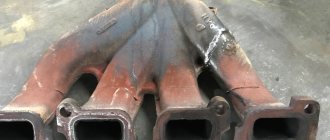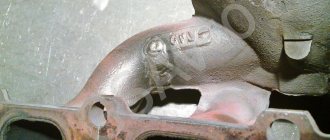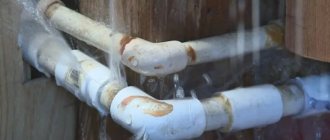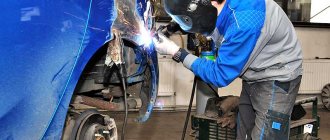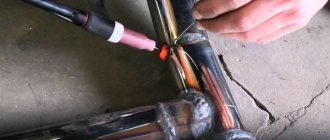During operation, some engine components wear out. This situation is typical for cars of any year of manufacture. However, if a part is damaged, you should not rush to buy a new one. Welding the exhaust manifold helps postpone the replacement procedure to a more favorable time.
The exhaust manifold is part of the attachments of an internal combustion engine.
Causes and signs of parts failure
The most common malfunctions are a violation of the integrity of the pipe or the appearance of a through hole in the manifold. The main sign of a breakdown is the smell of exhaust gases in the car interior. Malfunctions arise due to the negative effects of chemicals contained in mixtures used during icy conditions. Another reason is the natural wear of the part under constant exposure to high temperatures. Burnout of exhaust system components is not considered a rare failure.
A sign of a faulty collector is unstable operation at low speeds.
Cold welding when repairing the exhaust manifold
Small defects are repaired using special adhesives called “cold welding”. Before applying the mixture, the area to be repaired must be degreased. Adhesives should be used strictly according to the instructions. Then the result is a patch whose physical properties are similar to metal. This method is convenient for eliminating cracks and burnouts in hard-to-reach places. Glue is only a temporary measure to fix the damage. Under heavy loads of hot gases leaving the cylinders, the patched components will not last long. The adhesive composition is not designed for dynamic loads, but it can withstand static loads very well. Before purchasing glue, it is important to study its characteristics.
Installation and dismantling of parts
To remove and install the exhaust manifold, you will need the following tools:
- manual or hydraulic jack;
- container for collecting coolant;
- a set of socket, box and open-end wrenches;
- ratchet wrench;
- screwdrivers with flat and Phillips bits.
Installing an exhaust manifold is not a difficult task.
Dismantling and installation of the part is performed as follows:
- Study safety precautions when repairing engines. Reset battery terminals.
- Drain the coolant. To do this you will need a wrench, a basin and rubber gloves.
- Dismantle the injector receiver and remove the air filter. Using a wrench of a suitable size, remove the bolts where the manifold is attached to the cylinder block.
- When repairing an 8-valve engine, the intake manifold is removed. In such systems, fastening elements are common.
- Clean the cylinder heads from the remains of the burnt gasket with a file or sandpaper. In some cases, it is necessary to restore the threads or install new studs holding the manifold.
- New seals are installed. Mount the collector. When repairing a car with an 8-valve engine, the intake part is installed at the same time.
- Screw in the bolts and nuts. Connect the collector to the outlet pipes of the exhaust system.
- Check the correctness of installation work. Tighten the nuts tightly. Clean the radiator and fill it with new coolant. Connect the battery.
We recommend reading: Welding technology for internal combustion engine blocks
Collector device
When internal combustion engines operate, by-products are formed in the form of exhaust gases. They must be removed from the vehicle. This role is performed by the exhaust system. The first component of the exhaust system is the exhaust manifold.
The function of the manifold is to relieve the engine of exhaust gases. The purpose of the exhaust manifold is to collect exhaust gases from several cylindrical parts into one large pipe. It is rigidly fixed to the car engine.
Such a unit may have a different shape for different car models, but is a mandatory element in their design. Structurally, the exhaust manifold is a part in the form of several pipes - one pipe for each cylinder in the machine’s design.
There are solid manifolds, made by casting, and tubular, which are an integral connection of steel tubes and additional parts. The one-piece version, which does not have welded seams, is more durable. A gasket is installed between the cylinder block and the exhaust manifold to prevent exhaust gases from leaking into the space under the hood.
The presence of a collector increases the efficiency of cylinder ventilation. The most popular material for making a manifold is cast iron, which is a heat-resistant material.
Welding various materials at home
The restoration method is chosen taking into account the metal from which the collector is made.
Made of cast iron
To repair parts made from this alloy, the following methods are used:
- Gas welding. It is considered the most effective way to restore cast iron elements. Allows you to obtain a high-strength seam.
- Semi-automatic welding of cast iron exhaust manifold. To obtain a high-quality seam, complex preparation of the element is required. Special types of wire are used as filler material.
- TIG welding. The process is carried out in a protective gas environment, which prevents the occurrence of defects in the welded joint.
- Inverter method. In this case, careful cleaning of the surfaces of the cast iron element and installation of support pins are required.
If a crack is found in the collector, it is welded.
The crack is fused immediately after it appears; you should not wait for the pipe to be damaged. Before welding begins, the parts are warmed up. During operation, the properties of the metal are taken into account: it cools quickly.
Due to the increased fluidity of the material, holes are drilled along the seam or graphite spacers are installed.
Made of stainless steel
It is possible to qualitatively weld an exhaust manifold from this material only in a protective gas environment. If this rule is not followed, the part will become deformed due to strong heating. Taking into account the characteristics of stainless steel, only the following methods are allowed:
- Using an inverter with gas supply. In combination with such a welding machine, non-consumable tungsten electrodes are used.
- Manual welding with coated electrodes. It is necessary to constantly maintain the correct operating mode of the unit.
- Semi-automatic welding with a stainless steel electrode.
In domestic conditions, to obtain high-quality seams, you need to use MMA electrodes, rods with titanium or rutile coating.
Cold method
This method has nothing to do with the formation of a classic weld, however, it can be used for temporary repair of the exhaust system. Before starting work, it is necessary to study cold welding technology. The crack is eliminated as follows:
- The area to be treated is cleaned and degreased. Apply the adhesive according to the recommendations contained in the instructions.
- Wait for the product to dry and install the part in place. The result is a patch whose properties are similar to those of metal.
Recommended reading: Underwater welding
Under the load of hot exhaust gases, a part repaired in this way does not last long. This method can be used for welding a stainless steel manifold; it is not suitable for repairing a cast iron element.
Exhaust manifold: causes of failure and maintenance
Depending on the make of the car and the type of engine, models of various modifications are installed on the engine. They can be divided into two groups:
- all-metal, they are usually made by casting iron;
- tubular, for their production stainless pipes of various diameters are used.
The manifolds are attached to the internal combustion engine block using flanges. At each stroke, exhaust gases enter the chamber under pressure. Their temperature reaches 900 degrees. It is clear that a part operating in this mode can break.
A leak in the exhaust manifold is the most difficult defect. Possible situations:
- one of the pipes burns out;
- cracks appear on the collector due to dynamic load;
- The pipe breaks off completely.
Exhaust manifold crack
All this damage is a problem. For many cars, the procedure for replacing a part drags on for months - “original” spare parts sometimes have to be ordered.
Many service stations restore them. Welding of collectors, depending on their modification, is carried out using hot, cold or argon welding methods. The work is carried out using different types of equipment, using electrodes or filler wire. Restoration can be done in the courtyard or garage. How to weld the exhaust manifold yourself? Let's consider each of the methods in detail.
Features of welding titanium and its alloys
At the same time, welding of these materials is very difficult, which is explained by a number of their properties:
- high melting point (1470-1825℃);
- tendency to increase crystal sizes and the appearance of pores at temperatures above 880℃;
- oxidation of metal by atmospheric air, high chemical activity of all zones whose temperature exceeds 400℃;
- alloys containing iron, chromium, manganese, molybdenum, tungsten or vanadium are prone to hardening and have low ductility ; in some cases, they require annealing after welding.
These factors determined the need for welding titanium and its alloys in protective gas environments, primarily argon and helium. In addition, one of the main tasks of welding equipment involved in working with these metals is to minimize the time and area of thermal impact on both the seam and the areas adjacent to it.
Regardless of the type of welding and technological process used, the strength of the weld in relation to the strength of the base metal does not exceed 80%, which must be taken into account when designing titanium structures.
Currently, a search is underway for more efficient methods of joining the material.
How to prepare parts
To weld titanium, it is necessary to completely isolate the welded surfaces from the atmosphere, therefore, as a rule, automatic or semi-automatic welding is used.
Manual welding of titanium is possible, but only if a special welding torch with a ceramic nozzle is used, through which an inert gas, argon, is supplied under pressure to the welded areas, which displaces air.
In this case, the reverse side of the seam must be insulated from the atmosphere by tightly fitting steel or copper plates. To ensure the best quality of the seam, perforated pads are used, into the holes of which argon is supplied.
In the case of semi-automatic or automatic welding, it is carried out in a special capsule filled with argon or helium. Welding of titanium pipes can be carried out without placing the entire pipe in a protective gas environment, but the pipe itself must be sealed and filled with argon from the inside.
Another important nuance is to clean and degrease the welded surfaces 20 mm from the joint line. It is necessary to remove the oxide film, which is always present on the surface of a titanium product.
It is necessary to work with gloves, since hands, even clean ones, can leave sweat marks on the edge, which will lead to deterioration of the weld.
Before welding, titanium is additionally etched using a mixture of hydrochloric acid with water and sodium fluoride - 350 ml of HCl, 650 ml of distilled water, 50 g of sodium fluoride. Etching temperature is 60-65 °C, time is about 10 minutes.
After etching, titanium is thoroughly polished. For mechanical processing, sandpaper up to No. 12, wire brushes, and scrapers are used. It is necessary to make sure that the edges of the parts being welded are smooth and free of burrs and cracks. The filler wire is also stripped in the same way. Only after this can you start welding titanium.
Why is the collector damaged and possible consequences?
This problem can affect cars with any mileage. Over time, dynamic destruction inevitably occurs, but cracks often form due to manufacturing defects or incorrect assembly. Due to damage to the manifold, the exhaust system loses its tightness and air is automatically sucked into the exhaust pipe. As a result, the motor operates in cycles.
All modern cars have an oxygen sensor that monitors the amount of free oxygen in the exhaust gases. It is he who gives the signal to the control unit: to enrich or lean the mixture. When oxygen comes from outside, the sensor always considers the mixture lean and gives a signal to enrich it. As a result, the mixture becomes so oversaturated that it simply does not have time to burn and floods the candles. At this point, the driver may notice increased fuel consumption. Another problem is that the car does not immediately start moving after stopping in a traffic jam or at a traffic light.
An neglected problem can lead to failure of the catalyst or lambda probe. The exhaust manifold itself will also continue to deteriorate from overheating.
Manual process
Welding of alloys with titanium (in general) is carried out with direct current, straight polarity. The current depends on the thickness of the parts being connected, the caliber of the electrode and the diameter of the filler wire, and varies in the range of 90-200 A.
The higher the thickness of the metal, the greater the current supplied. Thus, parts 2 mm thick are connected at a current of 90 A, 3-4 mm - 130-140 A, 10 mm - 160-200 A. It is recommended to use the minimum possible current. The voltage is always the same - 10-15 V.
Electrodes
Non-consumable tungsten electrodes are used, which are sharpened at an angle of 30-45 °C (like a pencil) before starting work. The larger the sharpening angle, the shallower the penetration depth.
If used intensively, the electrode will need to be sharpened again as soon as it becomes dull. Electrodes containing lanthanum oxide are recommended, as their load-bearing capacity is 50% higher than that of pure tungsten products. Thanks to this, the weld will be less contaminated with tungsten, cleaner, and therefore stronger.
Wire
Filler wire is titanium wire of the appropriate alloy; it is selected specifically for the parts to be welded according to special tables. The wire should be annealed under vacuum to remove hydrogen that may be present in the alloy, and in any case it must be cleaned of oxides. The stripped wire is stored in an airtight tube for no more than 5 days.
If you weld metal with a thickness of no more than 1.5 mm using the butt method, then it is not necessary to use wire. A seam without an additive will be even stronger.
Features of the technology
During welding, a constant speed of movement of the electrode is maintained and a continuous supply of additive is ensured. The electrode speed should be approximately 2-2.5 mm/sec. It is necessary to maintain high precision of movements, to avoid vibrations and moving the electrode to the side. The electrode should touch the seam as if from bottom to top, welding proceeds “forward at an angle.”
During the entire process and for about a minute after switching off the burner, shielding gas must continue to be supplied to the fresh seam until the seam temperature drops below 400 °C.
In the welding zone, argon is consumed at a rate of 5-8 liters per minute, on the reverse side of the seam - 2 liters per minute.
When welding titanium pipes, their ends are sealed, and an inert gas - argon, or less often helium - is pumped inside using a special pump.
At home, in the absence of such equipment, it is impossible to weld titanium pipes. An exception is capacitor butt welding of titanium pipes of grade VT1-VT2, with a diameter of no more than 23 mm and a wall thickness of no more than 1.5 mm.
They can be welded outside a protective gas environment, but only using the capacitor method, at a high charging voltage - 850-2100 V.
Gas welding
The advantages of the gas welding method include:
- simplicity of the equipment used;
- low cost;
- lack of a constant current source;
- possibility of adjusting the power of the burner flame;
- slow heating and cooling;
- the strength of the resulting seam.
The technology of gas welding of cast iron with heating includes:
- Preheating.
- Heating the metal at the welding site until it turns light red.
- Applying flux to the welding surface using a filler rod.
- Melting the filler rod and filling the seam. At the tip of the filler rod, flux must be added periodically as it is used up.
- Keep the weld pool in a liquid state until gases and non-metallic inclusions are completely removed from it.
- Retracting the burner smoothly, reduce the cooling speed.
The technology of gas welding without heating has its differences:
- It is necessary to set the maximum possible burner flame power.
- Before filling the weld pool, the areas adjacent to the welding site are slightly heated.
- Flux is applied.
- The weld pool is filled with molten filler rod.
- Once again, the adjacent areas are heated for two to three minutes, gradually moving the burner away.
For slower cooling, you can cover the welding area with a sheet of asbestos or sprinkle it with dry sand. Welding the engine block with argon will bring good results.
The advantage of argon welding is the ability to weld refractory metals. This makes it possible to weld parts made of aluminum, which is important when welding an aluminum cylinder block.
The peculiarities of welding aluminum and alloys based on it include its easy oxidation, increased solubility of hydrogen in molten aluminum, a high coefficient of linear thermal expansion, and a decrease in strength under strong heating.
When welding aluminum alloys, there is a danger of porosity appearing in the weld metal. This is explained by the fact that when molten aluminum interacts with water vapor, the formation of atomic hydrogen begins, which easily dissolves in the weld pool. The formation of pores is promoted by a high rate of crystallization, which begins to prevent the escape of gases.
Preheating and reducing the welding speed help reduce the likelihood of porosity. When gas welding, it is permissible to use acetylene and hydrogen, as well as a propane-butane mixture, as flammable gases.
